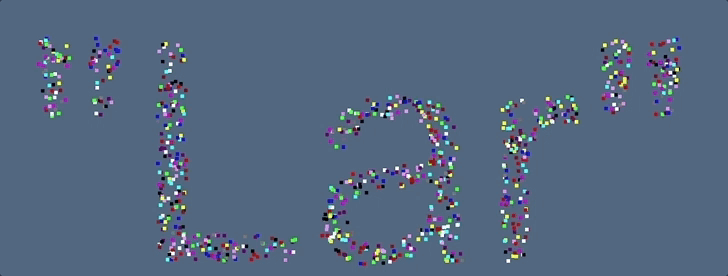4.2 - Alpha Structures Implementation
As previously said in section 3.3 we have addressed the problem of evaluate $\alpha$-structures via $\alpha$-filtering evaluation (namely the evaluation of the characteristical $\alpha$ for each simplex).

Figure 1: 2D Alpha Shape with various $\alpha$
The tasks
We could decompose the problem into three tasks:
- evaluate the triangulation decomposition of the Sites $S$
- evaluate the characteristical $\alpha$
- sort the simplices according to their $\alpha$.
The first task to solve is to evaluate the Triangulation. However we have discussed this problem in the previous section.
The last task also is pretty simple and teherefore we will not talk about it in this context.
The second task is the hardest to achieve. It is pretty clear that each site $s \in S$ has a characteristical $\alpha$ equal to zero. The real problem occurs then when we want to evaluate the characteristical $\alpha$ of all the other simplices.
Evaluate Characteristical $\alpha$
In order to obtain a simple method to evaluate characteristical $\alpha$ so that it is dimensional indipendent we could use the dual of the Delaunay Triangulation we have described in section 3.2: the Voronoy Diagram.
In fact the following relation occurs:
A $d$-dimensional simplex $\sigma$ is inside the $\alpha$-complex if and only if and only if the Voronoy regions of the sites of $sigma$ have a common $D-d$ intersection hyperplane included in the $alpha$-hypersphere of the sites themselves. In other words:
\[ \sigma \in \mathcal A_\alpha(S) \quad \iff \quad \bigcap_{t \in \sigma}\left(V_t(\alpha) \cap B_t(\alpha)\right) \ne \emptyset\]
To simplify this notion we could refer to what happend in the two dimensional case:
Let $S \in \mathbb R^2$ then:
- an edge $\overline{st}$ occurs in the $alpha$-complex if and only if the voronoy regions of $s$ and $t$ meet in a common edge that is less far from $s$ and $t$ than $\alpha$;
- a triangle $stq$ occurs in the $alpha$-complex if and only if the voronoy regions of $s$, $t$ and $q$ meet in a common point that is closer than $\alpha$ from the points themselves.
Of course we could overturn the point of view by looking what happend if we consider the $d-1$-dimensional ball $\mathcal B$ centered in the center of the circumball defined by the $d$ sites of $\sigma$. First of all we are sure it is well defined and unique since $S$ satisfies the general position condition. The stated condition then assume the following form:
A $d$-dimensional simplex made of sites $S'\subseteq S$ belongs to the $\alpha$-complex if and only if the ball of radius $\alpha$ located in the circumcentre of $S'$ intersects the Voronoy boundary hypersurface of the $S$ cells.
In particular the last statement implies that the characteristical $\alpha$ of a simplex $\sigma$ is always bigger or equal than the circumradius of the sites it is made of. Moreover for usual conditions (namely no higher dimensional obtuse-solid-angled simplices) the characteristical $\alpha$ is precisely that value.
This key feature is the one we have used in our implementation. In fact, the problem of determine if a simplex is (or is not) obtuse-angled is pretty simple. It suffices to determine if its circumcentre is (or is not, respectivelly) located outside the simplex itself.
The Pipeline
The approach we have followed could be summed up into the following pipeline:
- Delaunay triangulation of the Sites $S$ (highest degree simplices)
- Construction of lower degree simplices via
Combinatorics.combinations() - Evaluation of Circumballs Radius for each simplex
- Evaluation of the Characteristical $\alpha$ for each simplex
- Sorting the simplices by their $\alpha$ in a
DataStructures.SortedMultiDict
Example
julia> using AlphaStructures, ViewerGL
julia> GL = ViewerGL
julia> V = [
0.52 0.61 0.71 0.55 0.81 0.20 0.01 0.54 0.54 0.96 0.35 0.42 0.55 0.92 0.41 0.36 0.23 0.35 0.11 0.59
0.38 0.47 0.17 0.91 0.62 0.06 0.54 0.20 0.96 0.27 0.07 0.03 0.05 0.57 0.14 0.65 0.05 0.27 0.62 0.53
];
julia> filtration = AlphaStructures.alphaFilter(V);
SortedMultiDict(Base.Order.ForwardOrdering(),
0.0 => [1], 0.0 => [2], 0.0 => [3] …
0.8948905417047672 => [10, 13], 0.8948905417047672 => [3, 10, 13]
)
julia> VV,EV,FV = AlphaStructures.alphaSimplex(V,filtration,0.25)
3-element Array{Array{Array{Int64,1},1},1}:
[[1], [2], [3] … [18], [19], [20]]
[[1, 2], [1, 3], [1, 8] … [16, 20], [17, 18], [18, 19]]
[[1, 2, 3], [1, 2, 20], [1, 3, 8] … [11, 17, 18], [12, 13, 15], [16, 18, 19]]
julia> points = [[p] for p in VV];
julia> faces = [[f] for f in FV];
julia> edges = [[e] for e in EV];
julia> GL.VIEW( GL.GLExplode(V, [points; edges; faces], 1.5, 1.5, 1.5, 99, 1) );Main Interface
The solution we have proposed is located in the alphaFilter function (in this file):
AlphaStructures.alphaFilter — FunctionalphaFilter(
V::Matrix, DT = Array{Int64,1}[];
digits=64
)::DataStructures.SortedMultiDict{}Return ordered collection of pairs (alpha charatteristic, complex).
This method evaluates the α-filter over the sites S. If a Delaunay Triangulation DT is not specified than it is evaluated via AlphaStructures.delaunayTriangulation().
Examples
julia> V = [1. 2. 1. 2.; 0. 0. 1. 2. ];
julia> AlphaStructures.alphaFilter(V)
SortedMultiDict(Base.Order.ForwardOrdering(),
0.0 => [1],
0.0 => [2],
0.0 => [3],
0.0 => [4],
0.5 => [1, 2],
0.5 => [1, 3],
0.70710678118655 => [2, 3],
0.70710678118655 => [3, 4],
0.70710678118655 => [1, 2, 3],
1.0 => [2, 4],
1.0 => [2, 3, 4]
)
AlphaStructures.alphaSimplex — FunctionalphaSimplex(
V::Matrix,
filtration::DataStructures.SortedMultiDict{},
α_threshold::Float64
)::Array{Array{Array{Int64,1},1},1}Return collection of all d-simplex, for d ∈ [0,dimension], with characteristic α less than a given value α_threshold.
AlphaStructures.delaunayTriangulation — FunctiondelaunayTriangulation(V::Matrix)::Array{Array{Int64,1},1}Return highest level simplices of Delaunay triangulation.
Examples 1D
julia> V = [1. 2. 5. 6. 0. 7.];
julia> DT = AlphaStructures.delaunayTriangulation(V)
5-element Array{Array{Int64,1},1}:
[1, 5]
[1, 2]
[2, 3]
[3, 4]
[4, 6]Examples 2D
julia> V = [
1. 2. 1. 2. ;
0. 0. 1. 2.
];
julia> DT = AlphaStructures.delaunayTriangulation(V)
2-element Array{Array{Int64,1},1}:
[1, 2, 3]
[2, 3, 4]Examples 3D
julia> V = [
1. 2. 1. 2. ;
0. 0. 1. 2. ;
3. 1. 0. 2.
];
julia> DT = AlphaStructures.delaunayTriangulation(V)
1-element Array{Array{Int64,1},1}:
[1, 2, 3, 4]